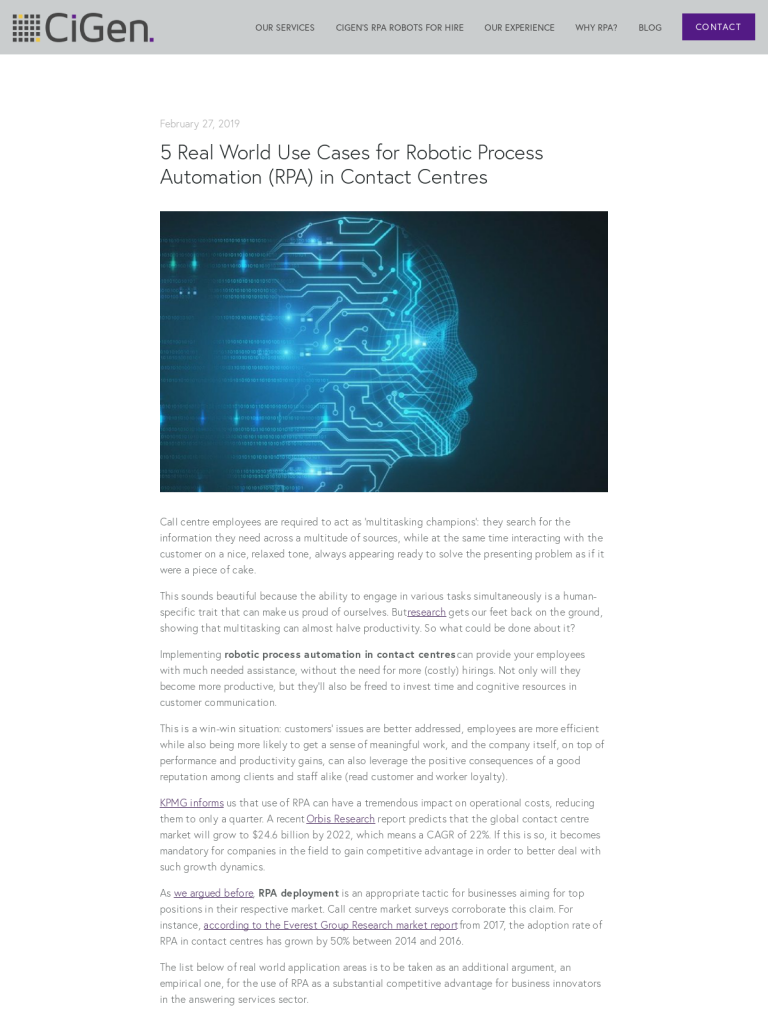5 Real World Use Cases for Robotic Process Automation (RPA) in Contact Centres
Original post from https://www.cigen.com.au/cigenblog/

Call centre employees are required to act as ‘multitasking champions’: they search for the information they need across a multitude of sources, while at the same time interacting with the customer on a nice, relaxed tone, always appearing ready to solve the presenting problem as if it were a piece of cake.
This sounds beautiful because the ability to engage in various tasks simultaneously is a human-specific trait that can make us proud of ourselves. But research gets our feet back on the ground, showing that multitasking can almost halve productivity. So what could be done about it?
Implementing robotic process automation in contact centres can provide your employees with much needed assistance, without the need for more (costly) hirings. Not only will they become more productive, but they’ll also be freed to invest time and cognitive resources in customer communication.
This is a win-win situation: customers’ issues are better addressed, employees are more efficient while also being more likely to get a sense of meaningful work, and the company itself, on top of performance and productivity gains, can also leverage the positive consequences of a good reputation among clients and staff alike (read customer and worker loyalty).
KPMG informs us that use of RPA can have a tremendous impact on operational costs, reducing them to only a quarter. A recent Orbis Research report predicts that the global contact centre market will grow to $24.6 billion by 2022, which means a CAGR of 22%. If this is so, it becomes mandatory for companies in the field to gain competitive advantage in order to better deal with such growth dynamics.
As we argued before, RPA deployment is an appropriate tactic for businesses aiming for top positions in their respective market. Call centre market surveys corroborate this claim. For instance, according to the Everest Group Research market report from 2017, the adoption rate of RPA in contact centres has grown by 50% between 2014 and 2016.
The list below of real world application areas is to be taken as an additional argument, an empirical one, for the use of RPA as a substantial competitive advantage for business innovators in the answering services sector.
Real world use cases for robotic process automation (RPA) in contact centres
1. Data management
Contact centres work with large amounts of customer data. When done manually, this can wreak havoc. Overloaded employees can ask customers to repeat their details multiple times, causing frustration and slowing down the resolution of the issue at hand. Even worse, accidentally swapping data bits may result in customers receiving information totally unrelated with what they asked for.
It’s easy to see that situations like these are likely to irritate customers, and thereby downgrade the credibility of the company. Robotic process automation can cancel out the risk of error when extracting, analysing and cross-referencing data across multiple sources. The employees can then invest all their resources in actually attending customers. In the end, both the customers and the employees are more satisfied and less stressed.
2. Creation of summary scripts
The versatility of software robots when it comes to data formats allows them to collect and analyse input data from phone calls. This streamlines note-taking activities and allows employees to focus their attention on actually listening to (not just hearing) customers’ requests, and thus address their requests more efficiently.
The automatic production of summary scripts also reduces the average handling time (AHT). Consequently, employees can take more calls and be more customer-oriented, both of which contribute to boosting productivity.
3. Updating client profiles
This is another example of a rule-based process to be performed upon successive instances of data collection (similar to point 2 from above). When the currently available data no longer fits with the client profile, the updating activity can be understood as applying a rule of the kind “maintain consistency”, where “consistency” is defined by equal values of specific parameters across multiple databases (e.g., email addresses, phone numbers, names).
This is a typical task that software robots ‘love’ to perform, warranting error-free updates and thereby smoothening customer interactions and avoiding discontent customers.
Thank you. We will be in touch shortly.
4. Prediction of customer needs and behaviour
Automating this process provides a very good illustration of technology integration. Building on data management capacities, software robots can scan, analyse, and cross-examine customers’ queries. Based on this, in collaboration with machine learning devices, they can predict with high accuracy what customers will want or do next.
Such predictions can be leveraged for user-friendly conversational interfaces, which allow more genuine human – robot interaction. The effect is a better understanding of customers, and a more personalised way of addressing their needs. Yet again, we see how deployment of robotic process automation in contact centres promises enhanced customer satisfaction.
5. Responding to customer complaints and inquiries
Customers’ statements of discontent, on top of the inherent call to be addressed that any kind of criticism poses, also bring about the challenge of dealing with unstructured data. Optical character recognition (OCR) can be used to scan customer letters, emails, or web forms and forward the structured input to software robots.
They can do a data check and, if necessary, add additional relevant details. The outcome, i.e. a recommended customer response, is automatically delivered to the case management system. An employee can then refine the content and ultimately send it to the customer.
Conclusion
What is the key takeaway of using RPA in contact centres? A significant increase in efficiency is the answer that arises out of all the real world use cases for robotic process automation in contact centres from the list above. This efficiency gain is underpinned by the mentioned concrete effects of software robots’ deployment, such as reduced error rates, AHT’s, or call holding time.
However, the most valuable efficiency trigger is the improvement of customer experience with the contact centre. Higher rates of first call resolution, less waiting time, personalised customer service – these are just some of the outcomes of implementing RPA in contact centres. If we also mention employees’ increased job satisfaction due to being able to forget the mindless, menial tasks and concentrate on empathic, conversational skills, we get a clearer picture of the person-centred benefits of robotic process automation in contact centres.
We end by mentioning once again that this is part of an ongoing series of articles about the particularities of RPA in different industries (finance, law, healthcare, etc.). If you found the information useful, please subscribe to our newsletter below to make sure that you stay updated with news about the fast-evolving automation services.
Leave a Comment
You must be logged in to post a comment.








